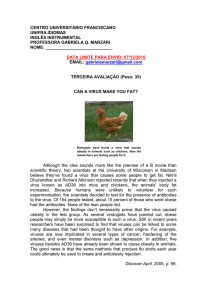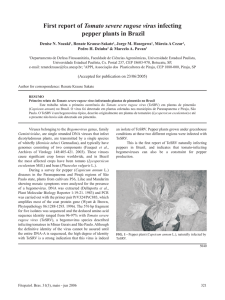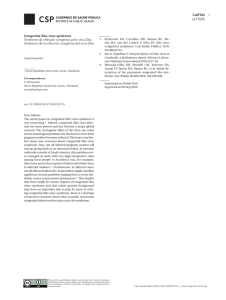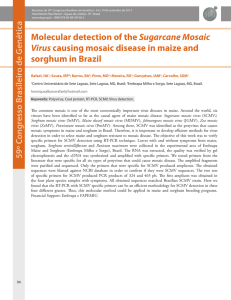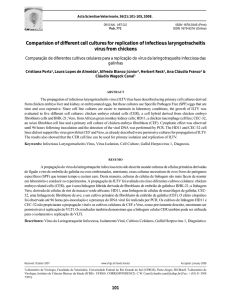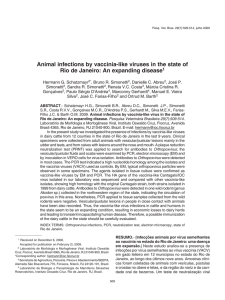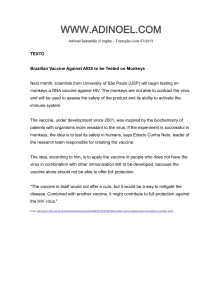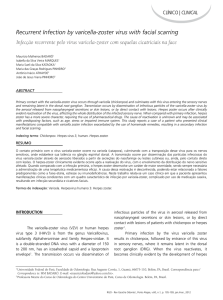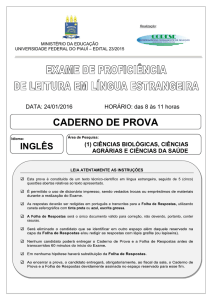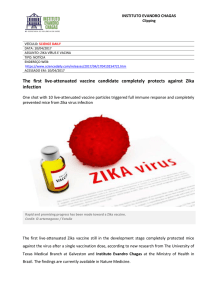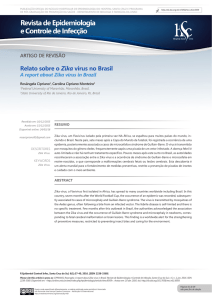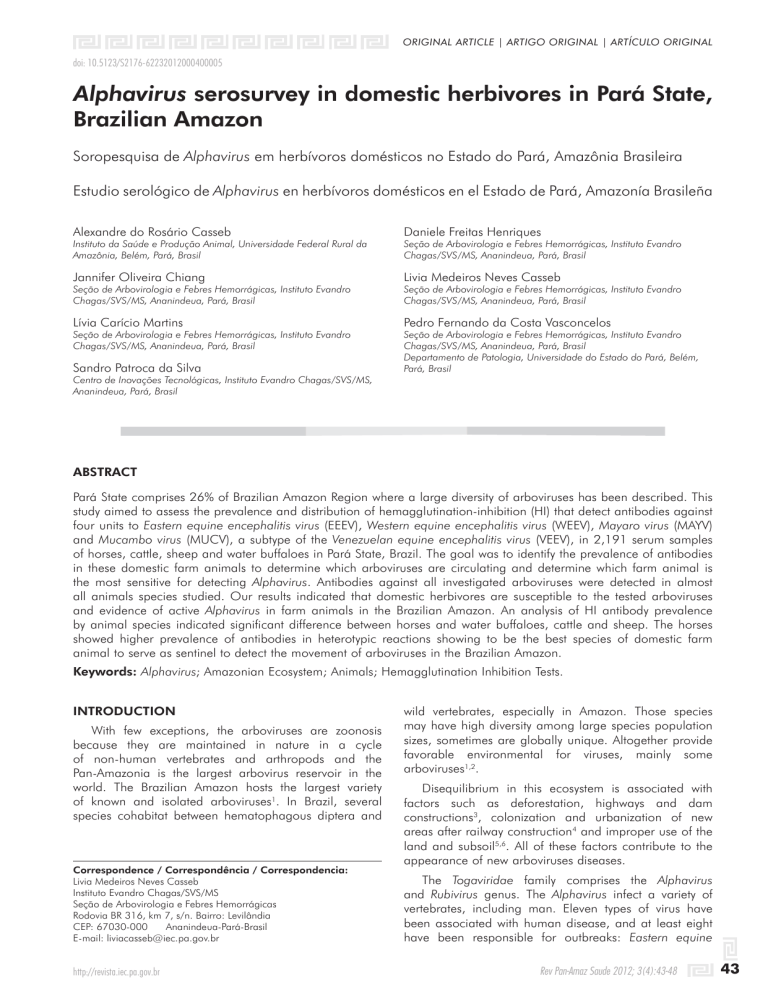
ORIGINAL ARTICLE | ARTIGO ORIGINAL | ARTÍCULO ORIGINAL
doi: 10.5123/S2176-62232012000400005
Alphavirus serosurvey in domestic herbivores in Pará State,
Brazilian Amazon
Soropesquisa de Alphavirus em herbívoros domésticos no Estado do Pará, Amazônia Brasileira
Estudio serológico de Alphavirus en herbívoros domésticos en el Estado de Pará, Amazonía Brasileña
Alexandre do Rosário Casseb
Daniele Freitas Henriques
Jannifer Oliveira Chiang
Livia Medeiros Neves Casseb
Lívia Carício Martins
Pedro Fernando da Costa Vasconcelos
Instituto da Saúde e Produção Animal, Universidade Federal Rural da
Amazônia, Belém, Pará, Brasil
Seção de Arbovirologia e Febres Hemorrágicas, Instituto Evandro
Chagas/SVS/MS, Ananindeua, Pará, Brasil
Seção de Arbovirologia e Febres Hemorrágicas, Instituto Evandro
Chagas/SVS/MS, Ananindeua, Pará, Brasil
Sandro Patroca da Silva
Seção de Arbovirologia e Febres Hemorrágicas, Instituto Evandro
Chagas/SVS/MS, Ananindeua, Pará, Brasil
Seção de Arbovirologia e Febres Hemorrágicas, Instituto Evandro
Chagas/SVS/MS, Ananindeua, Pará, Brasil
Seção de Arbovirologia e Febres Hemorrágicas, Instituto Evandro
Chagas/SVS/MS, Ananindeua, Pará, Brasil
Departamento de Patologia, Universidade do Estado do Pará, Belém,
Pará, Brasil
Centro de Inovações Tecnológicas, Instituto Evandro Chagas/SVS/MS,
Ananindeua, Pará, Brasil
ABSTRACT
Pará State comprises 26% of Brazilian Amazon Region where a large diversity of arboviruses has been described. This
study aimed to assess the prevalence and distribution of hemagglutination-inhibition (HI) that detect antibodies against
four units to Eastern equine encephalitis virus (EEEV), Western equine encephalitis virus (WEEV), Mayaro virus (MAYV)
and Mucambo virus (MUCV), a subtype of the Venezuelan equine encephalitis virus (VEEV), in 2,191 serum samples
of horses, cattle, sheep and water buffaloes in Pará State, Brazil. The goal was to identify the prevalence of antibodies
in these domestic farm animals to determine which arboviruses are circulating and determine which farm animal is
the most sensitive for detecting Alphavirus. Antibodies against all investigated arboviruses were detected in almost
all animals species studied. Our results indicated that domestic herbivores are susceptible to the tested arboviruses
and evidence of active Alphavirus in farm animals in the Brazilian Amazon. An analysis of HI antibody prevalence
by animal species indicated significant difference between horses and water buffaloes, cattle and sheep. The horses
showed higher prevalence of antibodies in heterotypic reactions showing to be the best species of domestic farm
animal to serve as sentinel to detect the movement of arboviruses in the Brazilian Amazon.
Keywords: Alphavirus; Amazonian Ecosystem; Animals; Hemagglutination Inhibition Tests.
INTRODUCTION
With few exceptions, the arboviruses are zoonosis
because they are maintained in nature in a cycle
of non-human vertebrates and arthropods and the
Pan-Amazonia is the largest arbovirus reservoir in the
world. The Brazilian Amazon hosts the largest variety
of known and isolated arboviruses1. In Brazil, several
species cohabitat between hematophagous diptera and
Correspondence / Correspondência / Correspondencia:
Livia Medeiros Neves Casseb
Instituto Evandro Chagas/SVS/MS
Seção de Arbovirologia e Febres Hemorrágicas
Rodovia BR 316, km 7, s/n. Bairro: Levilândia
CEP: 67030-000 Ananindeua-Pará-Brasil
E-mail: [email protected]
http://revista.iec.pa.gov.br
wild vertebrates, especially in Amazon. Those species
may have high diversity among large species population
sizes, sometimes are globally unique. Altogether provide
favorable environmental for viruses, mainly some
arboviruses1,2.
Disequilibrium in this ecosystem is associated with
factors such as deforestation, highways and dam
constructions3, colonization and urbanization of new
areas after railway construction4 and improper use of the
land and subsoil5,6. All of these factors contribute to the
appearance of new arboviruses diseases.
The Togaviridae family comprises the Alphavirus
and Rubivirus genus. The Alphavirus infect a variety of
vertebrates, including man. Eleven types of virus have
been associated with human disease, and at least eight
have been responsible for outbreaks: Eastern equine
Rev Pan-Amaz Saude 2012; 3(4):43-48
43
Casseb AR, et al. Alphavirus serosurvey in domestic herbivores in Pará State, Brazilian Amazon
encephalitis virus (EEEV), Western equine encephalitis
virus (WEEV), Venezuelan equine encephalitis virus
(VEEV), Mayaro virus (MAYV), O'Nyong-nyong virus
(ONNV), Ross River virus (RRV) Chikungunya virus
(CHIKV), and Getah virus (GEV)7.
ANIMALS AND SAMPLES
Inclusion Criteria: Animals aged from 2 years old,
without arbovirus vaccination, born and raised at the
collection site.
Exclusion Criteria: Animals younger than 2 years old,
vaccinated against any arbovirus or originating from any
other places than the collection site.
Infections in domestic herbivores by arboviruses
belonging to the genus Alphavirus manifest themselves
as systemic, encephalic and hemorrhagic syndromes.
The encephalic form is more common in horses, which
are mostly affected by EEEV and WEEV8.
Blood was collected throughout 2009 from animals
living in the six mesoregions of the Pará State (Figure 1).
The samples were collected by jugular vein vacuum
puncture, and the following domestic herbivores were
independent of sex and race: horses (Equus ferus), cattle
(Bos spp.), water buffalo (Bubalus bubalis) and sheep
(Ovis aries).
There are approximately 210 arboviruses isolated
in Brazil, with large majority of them in the Brazilian
Amazon9,10,11, however, a few studies have focused on
identifying the prevalence of antibodies in domestic
animals to determine which Alphavirus are circulating
and which farm animal is the most sensitive for detecting
these Alphavirus. Those are the goals of this study.
The animals were restrained and the local asepsis
was done, jugular vein was punctured, without
anticoagulant, using a vacuum system. From 5 to
10 mL of blood was collected and waited approximately
for 90 min to allow coagulation and serum
separation and it was subjected to centrifugation
at 2,000 rpm for 5 min. The separated serum was
transported on ice and then stored at -70º C until
being analyzed by serologic testing. A total of 2,191
serum samples were collected: 385 from sheep, 399
from cattle, 654 from water buffaloes and 753 from
horses.
MATERIALS AND METHODS
ETHICAL FEATURES
Alenquer
All procedures which involved newborn (2-3 days
old) of Swiss albino mice and domestic animals were
done to avoid undue suffering. This study was approved
by the Animal Research Ethics Committee (CEPAN) of
the Instituto Evandro Chagas (IEC) (protocol 054/2009
CEPAN/IEC) in November 27, 2009.
Belém
Bujaru
Castanhal
Nova Timboteua
Peixe-boi
Capanema
Soure
Salvatera
Bragança
Tomé-açu
Pra
Santarém
inh
a
Capitão Poço
Brasil Novo
Vitória do Xingu
Ipixuna do Pará
Tailândia
Tucuruí
m
go
a
Par
s
ina
Metropolitan Region
of Belém
Baixo Amazonas
Marajó
Northeast
of Pará
Altamira
Xinguara
Southwest of
Pará
Redenção
A
Southeast of
Pará
B
A: collecting municipalities; B: the division into mesoregions of Pará State.
Figure 1 – Schematic representation of the Pará State indicating were collected from the domestic herbivores serum samples
44
Rev Pan-Amaz Saude 2012; 3(4):43-48
Casseb AR, et al. Alphavirus serosurvey in domestic herbivores in Pará State, Brazilian Amazon
HEMAGGLUTINATION-INHIBITION (HI) TEST
When was observed each species of arboviruses and
studied animal, the HR showed the following results:
equine - EEEV (67.4%), MUCV (85.7%), WEEV (86%)
and MAYV (90%); water buffaloes - EEEV (28.3%), WEEV
(41.2%), MUCV (53.1%) and MAYV (69.2%); bovine EEEV (33.3%), MUCV (25%), WEEV (7.40%) and MAYV
(0%); ovine - EEEV (33.33%); the other alphaviruses
did not show positive HR. The MR were: equine - EEEV
(32.6%), WEEV (13.95%), MAYV (10.0%) and MUCV
(14.3%); water buffaloes - EEEV (71.7%), WEEV (60.8%),
MAYV (30.8%) and MUCV (46.9%); bovine - EEEV
(66.7%), WEEV (92.6%), MAYV (100%) and MUCV (75%);
ovine - EEEV (66.7%), WEEV (100%) and MUCV (100%).
HI test was performed following protocol described
by Shope12. This test was performed with antigens from
EEEV, WEEV, MAYV and Mucambo virus (MUCV) isolated
in Brazil. This virus belonged to the collection of the
Arbovirology and Hemorrhagic Fevers Division of the
IEC, Ananindeua, Pará State, Brazil. These antigens were
prepared from infected brain, liver or serum of newborn
mice, and sera were tested against four antigen units13.
The criteria for positivity as monotypic (reaction against
only one antigen) or heterotypic (reactions against two
or more antigens of the same virus genus, that may
indicate cross reaction) was used14.
STATISTICAL ANALYSIS
DISCUSSION
The proportion method recommended by the
Brazilian Ministry of Health was used to evaluate data9.
Susceptibility tests were conducted on Lowenstein-Jensen
medium. Antibiotics were applied in the recommended
critical concentrations of 0.2 μg/mL for H, 40.0 μg/mL
for R, 2.0 μg/mL for E, 25.0 μg/mL for Z, 4.0 μg/mL for
S and 20.0 μg/mL for Et.
The current study determined the prevalence of HI
antibodies against EEEV, WEEV, MAYV and MUCV in four
species of domestic herbivores. Of the Alphavirus, all of
them have already been isolated from arthropods and/or
wild vertebrates and also from humans in Brazil. Only
the EEEV and WEEV have been proven to cause disease
in domestic herbivores (horses).
In Brazilian Amazon, EEEV and WEEV have been
isolated from birds, horses and mosquitoes in Belém
Metropolitan Region and Southern Pará. Antibodies
against these arboviruses have also been found, with
a low prevalence in wild mammals16. The results of
this study indicated a high prevalence of HI antibodies
against EEEV and WEEV in horses, which showed a
frequent exposure of this population to mosquitoes that
carry these arboviruses, in order to confirm even the MR,
it is necessary to conduct more specific tests such as the
plaque reduction neutralization test (PRNT) or molecular
studies as the next-generation sequencing (NGS).
The analysis was done using the Chi-square test and
the sample scores were measured using a significance
level of 0.05 (BioEstat v.5.0 software)15.
RESULTS
All equine, bovine and water buffaloes presented
high serologic prevalence to the four alphaviruses used
in this study; the sheep did not present HI antibodies to
MAYV. The total reactions (TR), heterotypic reactions (HR)
and monotypic reactions (MR) are shown in table 1.
The HR correspond to 65.7% while MR represented
34.7% of all positive reactions. The HR of animal
species comparing to the TR were: equine 77.9%, water
buffaloes 42.8%, bovine 11.4% and ovine 9.1%. The
equine showed HR higher than other animal species
(p < 0.0001). The water buffaloes have also presented
HR significantly higher than other ruminant species
(p < 0.0001), but no differences were found among
bovine and ovine prevalences.
Despite the lack of reports on clinical disease in
horses, only one epizootic outbreak by EEEV has been
reported in the Municipality of Bragança, Pará State,
in 196217; however there are no reported cases of
encephalitis in human in the Amazon Region caused
by those arboviruses18. But, EEEV caused neurological
illness in human beings in the North America8, and
two fatal cases had been reported in South America,
one in Brazil, in Bahia State19 and the other one in
Trinidad and Tobago20. Aguilar et al21 report that the low
incidence of cases of human encephalitis in the South
America probably is due to the low infectivity and not the
virulence of the isolated cases of EEEV that circulate in
that region.
The MR of animal species comparing to the TR were:
ovine 90.9%; bovine 88.67%; water buffaloes 57.8%
and equine 22.1%. No statistic difference was found
in the ovine and bovine (p = 0.9203) analysis, but
significant differences were obtained in the other species
analyzed (p < 0.001).
Table 1 – Prevalence of HI antibodies against four tested Alphavirus types in sera of domestic herbivores with heterotypic
reactions (HR), monotypic reactions (MR) and total reactions (TR)
Virus
Horse
Cattle
Water buffalo
Sheep
%HR
%MR
%TR
%HR
%MR
%TR
%HR
%MR
%TR
%HR
%MR
%TR
EEEV
20.3
9.8
30.1
0.25
0.50
0.75
2.3
5.8
8.1
0.26
0.5
0.8
WEEV
19.6
3.2
22.8
0.50
6.7
6.8
3.2
4.7
7.8
–
1.8
1.8
MAYV
4.8
0.5
5.3
–
0.25
0.25
1.4
0.6
2.0
–
–
–
MUCV
7.2
1.2
8.4
0.25
0.75
1.0
4.0
3.5
7.5
–
0.25
0.25
Total
51.9
14.7
66.6
1.00
8.2
8.8
10.9
14.6
25.4
0.26
2.55
2.85
Conventional sign used: – Numeric data not equal to zero due to rounding.
Rev Pan-Amaz Saude 2012; 3(4):43-48
45
Casseb AR, et al. Alphavirus serosurvey in domestic herbivores in Pará State, Brazilian Amazon
Some epizootic strains of VEEV may be transmitted
from horse to human by mosquitoes and the epidemic
transmission cycle of VEEV involves horses which are the
main source of the virus, namely, the source of infection
for new hematophagous mosquitoes22. The MUCV subtype
III of VEEV23 is usually isolated in Amazoni and it has been
associated with sporadic febrile syndromes in humans in
Brazil, Trinidad and Tobago, Surinam and French Guiana.
The virus illness has evolved without important
complications and without a record of epidemics24. It
has also been isolated in Southeastern Brazil, close
to the Vale do Ribeira, in São Paulo State25; however,
there are no reports of that disease in domestic animals.
Nevertheless, a 10 month-old equine experimentally
infected via intramuscular route with high doses of
MUCV has developed viremia which lasted for three
days, with fever that lasts for 24 h and persistent
leucopenia26. Additionally, Iverson et al27 found
anti-MUCV antibodies in an equine that had symptoms
compatible to encephalitis in the Brazilian Pantanal.
Ulloa et al28 found 45% of positivity for antibodies by
plaque reduction neutralization test (PRNT) for the cattle
in VEEV in Mexico. These data contrasted with those
observed in this current study, where MUCV prevalence
in cattle was just 1% of positivity for antibodies HI. It
is interesting to note a greater percentage of positive
reactions to horse antibody HI (8.36%) and water
buffalo (7.49%).
MAYV was first isolated in Trinidad and Tobago in
195429 and is frequently isolated in northern of South
America from humans, wild vertebrates (mainly monkeys)
and mosquitoes. Outbreaks in humas caused by the
virus of that febrile exanthematous disease have been
frequently reported in Amazonia11,30,31. In this study, the
prevalence of HI antibodies against MAYV in domestic
herbivores was low. It should be noticed that antibodies
against this virus were not detected in sheep during HI
test, despite cohabitation with other animal species that
did exhibit positive reactions against MAYV. There are no
reports of any disease caused by this virus in domestic
animals; however, the clinical syndromes that appear in
humans presents symptoms that may not be perceived in
domestic animals such as horses and ruminants.
In the International Catalogue of Arboviruses are
registered approximately one hundred forty arboviruses
infecting humans and farm animals, and some of these
arboviruses infections only cause sub-clinical disease
detected by the presence of antibodies32. In this study,
domestic herbivores showed different prevalences of HI
antibodies to the Alphavirus analyzed with the higher
prevalence for horses, which may be related to the
thickness of the skin which is thinner than those of the
ruminants, thereby easing up the infection. On the other
hand, the water buffalo has the keratin layer of the skin
thicker than the cattle, because buffaloes have the habit of
living in flooded regions where there is the greatest amount
of arthropods, so increasing the probability of infection
since there was higher prevalence of antibodies to the
Alphavirus HI compared to other ruminants analyzed.
CONCLUSION
In the Brazilian Amazon, farm animals may have
exposed for thousands of mosquito bites in areas where
could be used as transmission for this virus. It only
takes one infected mosquito to cause seroconversion.
But there is no evidence that domestic farm animals
are frequently exposed to arboviruses, it may represent
a public health risk to humans that ca be susceptible to
develop disease from that virus. Thus, it is possible to
infer that horses showed higher prevalence of antibodies
in heterotypic reactions showing to be the best species of
domestic farm animal to serve as sentinel to detect the
movement of arboviruses in the Brazilian Amazon.
ACKNOWLEDGMENTS
Our gratitude to the IEC/SVS/MS and the
Universidade Federal Rural da Amazônia who
contributed greatly to the development of this research.
FINANCIAL SUPPORT
This study was partially supported by the National
Council for Scientific and Technological Development
(CNPq) (grant 301641/2010-2).
Soropesquisa de Alphavirus em herbívoros domésticos no Estado do Pará, Amazônia
Brasileira
RESUMO
O Estado do Pará compreende 26% da Amazônia brasileira, onde uma grande diversidade de arbovírus é descrita. Este
estudo teve como objetivo avaliar a prevalência e distribuição de inibição da hemaglutinação (HI) que detecta anticorpos
contra quatro tipos de vírus: vírus da encefalite equina do leste (EEL), vírus da encefalite equina do oeste (EEO), vírus
Mayaro (MAYV) e vírus Mucambo (MUCV), um subtipo do vírus da encefalite equina venezuelana (VEEV), em 2.191
amostras de soro de equinos, bovinos, ovinos e bubalinos no Estado do Pará, Brasil. O objetivo foi identificar a prevalência
de anticorpos nestes animais de fazenda para determinar quais arbovírus estão circulando e determinar que animal é mais
sensível para detectar Alphavirus. Os anticorpos contra os arbovírus investigados foram detectados em quase todos os
animais das espécies estudadas. Os resultados indicaram que herbívoros domésticos são suscetíveis aos arbovírus testados
e evidencia Alphavirus ativos em animais de fazenda na Amazônia brasileira. Uma análise da prevalência de anticorpos
HI por espécies de animais indicaram diferença significativa entre equinos e bubalinos, bovinos e ovinos. Os equinos
apresentaram maior prevalência de anticorpos em reações heterotípicas, os quais demonstram ser as melhores espécies
de animais de fazenda como sentinelas para detectar a circulação de arbovírus na Amazônia brasileira.
Palavras-chave: Alphavirus; Ecossistema Amazônico; Animais; Testes de Inibição da Hemaglutinação.
46
Rev Pan-Amaz Saude 2012; 3(4):43-48
Casseb AR, et al. Alphavirus serosurvey in domestic herbivores in Pará State, Brazilian Amazon
Estudio serológico de Alphavirus en herbívoros domésticos en el Estado de Pará,
Amazonía Brasileña
RESUMEN
El Estado de Pará comprende 26% de la Amazonía brasileña, en la cual se describe una gran diversidad de arbovirus.
Este estudio tuvo como objetivo evaluar la prevalencia y distribución de inhibición de la hemoaglutinación (HI) que
detecta anticuerpos contra cuatro tipos de virus: virus de la encefalitis equina del este (EEE), virus de la encefalitis
equina del oeste (EEO), virus Mayaro (MAYV) y virus Mucambo (MUCV), un subtipo del virus de la encefalitis equina
venezolana (EEV), en 2.191 muestras de suero de equinos, bovinos, ovinos y bufalinos en el Estado de Pará, Brasil.
El objetivo fue el de identificar la prevalencia de anticuerpos en estos animales de hacienda para determinar cuales
arbovirus están circulando y determinar que animal es más sensible para detectar Alphavirus. Los anticuerpos contra
los arbovirus investigados fueron detectados en casi todos los animales de las especies estudiadas. Los resultados
indicaron que los herbívoros domésticos son susceptibles a los arbovirus testados y evidencia Alphavirus activos en
animales de hacienda en la Amazonía brasileña. Un análisis de la prevalencia de anticuerpos HI por especies de
animales indicó una diferencia significativa entre equinos y bufalinos, bovinos y ovinos. Los equinos presentaron mayor
prevalencia de anticuerpos en reacciones heterotípicas y demuestran ser las mejores especies de animales de hacienda
como centinelas para detectar la circulación de arbovirus en la Amazonía brasileña.
Palabras clave: Alphavirus; Ecosistema Amazónico; Animales; Pruebas de Inhibición de Hemaglutinación.
REFERENCES
1 Leão RNQ, organizador. Doenças infecciosas e
parasitárias: enfoque amazônico. Belém: CEJUP;
1997.
2 Vasconcelos PFC, Travassos da Rosa APA,
Dégallier N, Travassos da Rosa JFS, Pinheiro FP.
Clinical and ecoepidemiological situation of human
arboviruses in Brazilian Amazonia. Cienc Cult. 1992
Mar-Jun;44(2/3):117-24.
3 Vasconcelos PFC. Emergence of arboviruses in
Brazilian Amazon Region. Virus Rev Res. 1999;4
Suppl 1:48-9.
4 Le Duc JW, Piheiro FP. Oropouche fever. In: Monath
TP, editor. The arboviruses: epidemiology and ecology.
Boca Raton: CRC Press; 1988. p. 1-14.
5 Dégallier N, Travassos da Rosa APA, Vasconcelos
PFC, Rodrigues SG, Travassos da Rosa ES, Sá Filho
GC, et al. New entomological and virological data
on the vectors of sylvatic yellow fever in Brazil. Cienc
Cult. 1992 Mar-Jun;44(2/3):136-42.
6 Vasconcelos PF, Travassos da Rosa AP, Rodrigues SG,
Travassos da Rosa ES, Degallier N, Travassos da Rosa
JF. Inadequate management of natural ecosystem in
the Brazilian Amazon region results in the emergence
and reemergence of arboviruses. Cad Saude Publica.
2001;17 Suppl:155-64.
7 Calisher CH, Shope RE, Brandt W, Casals J,
Karabatsos N, Murphy FA, et al. Proposed antigenic
classification of registered arboviruses I. Togaviridae.
Alphavirus. Intervirology. 1980;14(5-6):229-32.
8 Weaver SC, Reisen WK. Present and future arboviral
threats. Antiviral Res. 2010 Feb;85(2):328-45.
9 Vasconcelos AA, Pinheiro FP, Shope RE, Travassos
da Rosa JFS, Travassos da Rosa ES, Dégallier N,
et al. Arboviruses pathogenic for man in Brazil. In:
Travassos da Rosa APA, Vasconcelos PFC, Travassos
da Rosa JFS, editors. Overview of arbovirology in
Brazil and neighbouring countries. Belém: Instituto
Evandro Chagas; 1998. p. 72-99.
10 Martins LC, Diniz JA, Silva EV, Barros VL, Monteiro HA,
Azevedo RS, et al. Characterization of Minacu virus
(Reoviridae: Orbivirus) and pathological changes
in experimentally infected newborn mice. Int J Exp
Pathol. 2007 Feb;88(1):63-73.
11 Azevedo RS, Silva EV, Carvalho VL, Rodrigues SG,
Nunes-Neto JP, Monteiro H, et al. Mayaro fever
virus, Brazilian Amazon. Emerg Infect Dis. 2009
Nov;15(11):1830-2.
12Shope RE. The use of micro-hemagglutination
inhibition test to follow antibody response after
arthropod-borne virus infection in a community of
forest animals. An Microbiol. 1963;11:167-71.
13 Clarke DH, Casals J. Techniques for hemagglutination
and hemagglutination-inhibition with arthropod-borne
viruses. Am J Trop Med Hyg. 1958 Sep;7(5):561-73.
14 Rodrigues SG, Oliva OP, Araújo FAA, Martins LC,
Chiang JO, Henriques DF, et al. Epidemiology of
Saint Louis encephalitis virus in the Brazilian Amazon
region and in the State of Mato Grosso do Sul, Brazil:
elevated prevalence of antibodies in horses. Rev
Pan-Amaz Saude. 2010 Mar;1(1):81-6.
15 Ayres M, Ayres Jr M, Ayres DL, Santos AS. BioEstat
5.0: aplicações estatísticas nas áreas das ciências
biológicas e médicas. Belém: Sociedade Civil
Mamirauá; 2007.
Rev Pan-Amaz Saude 2012; 3(4):43-48
47
Casseb AR, et al. Alphavirus serosurvey in domestic herbivores in Pará State, Brazilian Amazon
16 Shope RE, Andrade AH, Bensabath G, Causey OR,
Humphrey PS. The epidemiology of EEE, WEE, SLE
and Turlock viruses, with special reference to birds,
in a tropical rain forest near Belem, Brazil. Am J
Epidemiol. 1966 Nov;84(3):467-77.
17 Causey OR, Shope RE, Laemmert HW. Report of an
epizootic of encephalomyelitis virus in Pará, Brazil.
Rev Ser Esp Saude Publica. 1962;12:47-50.
18Woodall J. Notas históricas de alguns arbovírus
isolados no laboratório de vírus de Belém da
Fundação Rockefeller. In: 3° Simpósio Internacional
de Arbovírus dos Trópicos e Febres Hemorrágicas;
2004 30 nov-3 dez; Belém; Belém: Instituto Evandro
Chagas; 2004. p. 12-3.
19Alice FJ. Infecção humana pelo vírus "leste" da
encefalite equina. Bol Inst Biol Bahia. 1956;3:3-9.
20 Corniou B, Ardoin P, Bartholomew C, Ince W, Massiah
V. First isolation of a South American strain of Eastern
Equine virus from a case of encephalitis in Trinidad.
Trop Geogr Med. 1972 Jun;24(2):162-7.
21Aguilar PV, Robich RM, Turell MJ, O'Guinn ML,
Klein TA, Huaman A, et al. Endemic eastern equine
encephalitis in the Amazon region of Peru. Am J Trop
Med Hyg. 2007 Feb;76(2):293-8.
22 Stott JL. Togaviridae e Flaviviridae. In: Hirsh DCZ,
Chung YC, editores. Microbiologia veterinária. Rio
de Janeiro: Guanabara Koogan; 2003. p. 358-67.
23Young NA, Johnson KM. Antigenic variants of
Venezuelan equine encephalitis virus: their geographic
distribution and epidemiologic significance. Am J
Epidemiol. 1969;89(3):286-307.
24 Causey OR, Causey CE, Maroja OM, Macedo DG.
The isolation of arthropod-borne viruses, including
members of two hitherto undescribed serological
groups, in the Amazon region of Brazil. Am J Trop
Med Hyg. 1961 Mar;10(2):227-49.
25 Lopes OS, Sachetta LA. Isolation of Mucambo virus,
a member of the Venezuelan equine encephalitis virus
complex in the State of São Paulo, Brazil. Rev Inst Med
Trop Sao Paulo. 1978 Mar-Apr;20(2):82-6.
26 Shope RE, Causey OR, Andrade AH, Theiler M. The
Venezuelan equine encephalomyelitis complex of
group a arthropod-borne viruses, including Mucambo
and Pixuna from the Amazon Region of Brazil. Am J
Trop Med Hyg. 1964 Sep;13:723-7.
27 Iversson LB, Silva RA, Rosa AP, Barros VL. Circulation
of eastern equine encephalitis, western equine
encephalitis, Ilheus, Maguari and Tacaiuma viruses in
equines of the Brazilian Pantanal, South America. Rev
Inst Med Trop Sao Paulo. 1993 Jul-Aug;35(4):355-9.
28Ulloa A, Langevin SA, Mendez-Sanchez JD,
Arredondo-Jimenez JI, Raetz JL, Powers AM, et al.
Serologic survey of domestic animals for zoonotic
arbovirus infections in the Lacandon Forest region of
Chiapas, Mexico. Vector Borne Zoonotic Dis. 2003
Jul;3(1):3-9.
29 Anderson CR, Downs WG, Wattley GH, Ahin NW,
Reese AA. Mayaro virus: a new human disease agent.
II. Isolation from blood of patients in Trinidad, B.W.I.
Am J Trop Med Hyg. 1957 Nov;6(6):1012-6.
30 Pinheiro FP, Freitas RB, Travassos da Rosa JF, Gabbay
YB, Mello WA, LeDuc JW. An outbreak of Mayaro virus
disease in Belterra, Brazil: I. Clinical and virological
findings. Am J Trop Med Hyg. 1981 May;30(3):
674-81.
31Pinheiro FP. Arboviral zoonoses in South America
Mayaro fever. In: Baran GW, editor. Handbook
series in zoonoses. Boca Raton: CRC Press; 1981. p.
159-64.
32Karabatsos N, editor. International catalogue of
arboviruses, including certain other viruses of
vertebrates. 3rd ed. San Antonio: American Society of
Tropical Medicine and Hygiene; 1985. p. 1141.
Received / Recebido em / Recibido en: 28/5/2012
Accepted / Aceito em / Aceito en: 23/11/2012
48
Rev Pan-Amaz Saude 2012; 3(4):43-48

